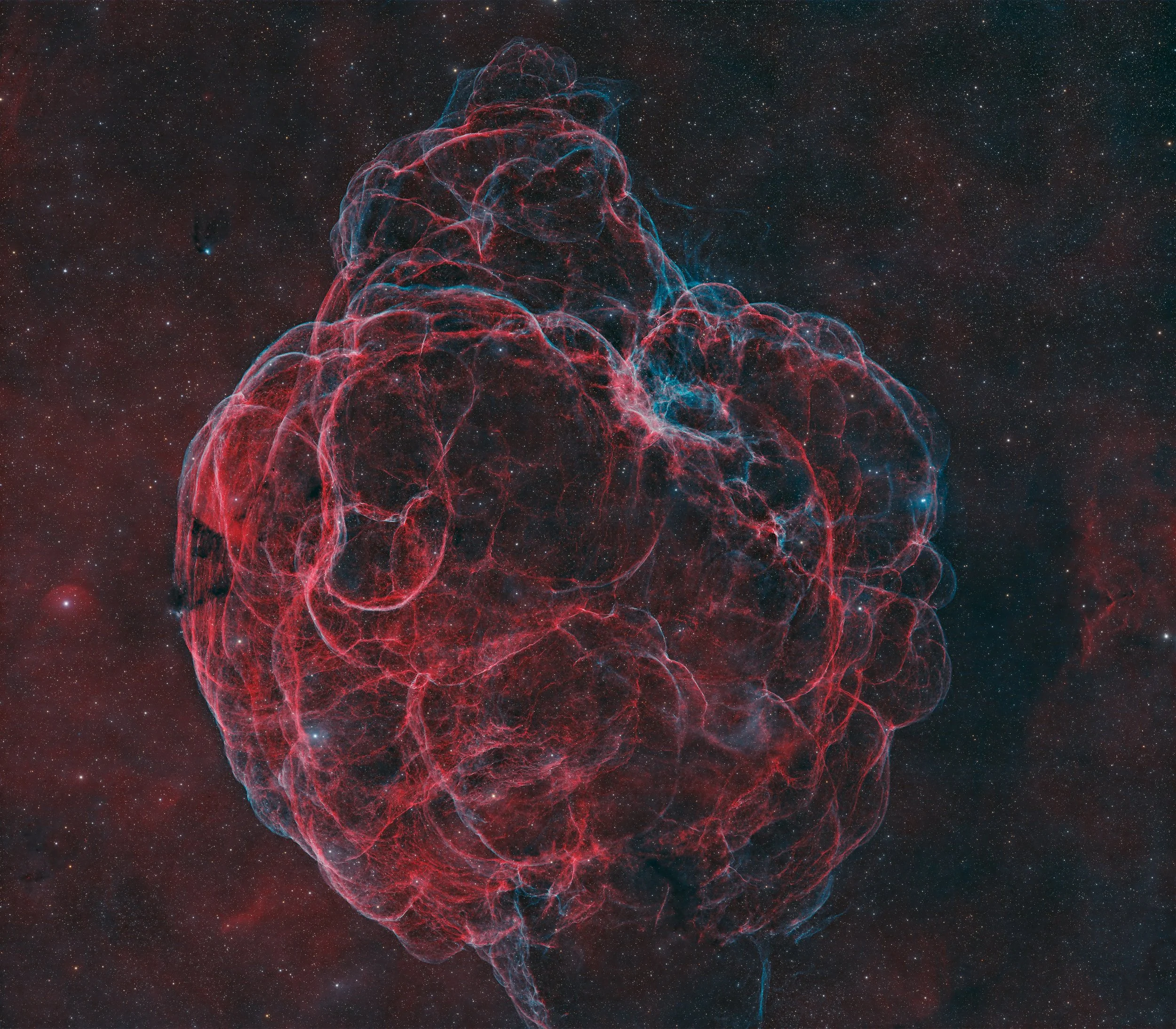Spaghetti Nebula
About the Subject
The Spaghetti Nebula is a supernova remnant lying on the border between Taurus and Auriga. Despite covering a large area of sky (roughly three degrees across), it wasn't discovered until 1952 because the surface brightness is extremely low. It was found in on narrow band photographic plate taken at the Crimean Observatory. This supernova remnant has an estimated age of 40,000 years. At the estimated distance of 3,000 lightyears, that would correspond to a physical size of roughly 160 lightyears. That means the remnants of the explosion have been traveling outwards from the source at more roughly 2.5% of the speed of light or 7,500 km/s. At that speed, a trip from New York to London would take just three quarters of a second!
The supernova that created Simeis 147 left behind a pulsar, a spinning neutron star that emits radio waves that appear to pulse as the star rotates, much like a lighthouse light. The pulsar PSR J0538+2817 which was found in 1996 is thought to be the remains of the star that exploded to form this nebula. You can see the location of PSR J0538+2817 marked in green in the second version of the image at left. There is no obvious visible light counterpart, so only the marked location can be seen. The pulsar has a relatively slow period (for a pulsar) of 143 ms.
About the Image
This is an HOO image with RGB stars. That means the nebulosity was captured in H-alpha and doubly ionized oxygen. The hydrogen emissions were mapped to red, and the oxygen emissions were mapped to both green and blue. This is fairly close to a true color representation of the two gasses as hydrogen alpha is, in fact, a deep ruby red color, and OIII is a teal color, roughly halfway between blue and green. Straight HOO images generally look somewhat artificial since it is impossible to get accurate star colors with just two wavelengths of light. As a result, a relatively small dataset of red, green and blue was used for just the stars themselves.
The total integration time for the image was 131 hours across all filters and panels. In addition to the full color image, you can see an image with the location of PSR J0538+2817 marked, and an image showing just the H-alpha component of light.
Astro-Physics APCC was used for mount control and for building a large tracking model of the sky. The mount was also guided using a separate guide scope and PHD2 software using half second exposures. Because of the large size of the subject, NINA was used to setup a twelve panel mosaic in order to frame the entire target. There are four rows and three columns of images combined into the final result. Mosaics across such a large swath of sky are challenging as a result of light pollution gradients. This process was helped tremendously by the recent release of PixInsight MARS data which allows very accurate gradient correction based on reference frames. NINA was used for all image capture and hardware control. PixInsight was used for pre and post processing of the image.
Date, Location, and Equipment:
November 15, 2024 to January 3, 2025, Rowe, NM, USA
Astro-Physics 305mm Riccardi-Honders Cassegrain @ f/3.8
Astro-Physics 1100GTO AE Mount with Absolute Encoders
QHY600PH Monochrome Camera at -10°C
Chroma 50mm x 50mm filters
3nm H-Alpha
3nm OIII
RGB
68h45m H-alpha, 50h45m OIII, 11h41m RGB
Twelve panel mosaic
Software:
Astro-Physics APCC for mount control and advanced pointing model
NINA for autofocus, sequence of images, and camera control
PHD2 for guiding
PixInsight for calibration and all post processing
This is a bi-color image using narrowband filters capturing H-alpha and OIII wavelengths of light. The colors were mapped using a traditional HOO palette for narrowband images. The narrowband starless image was merged with a separate set of exposures for RGB stars in order to create anatural appearing final result.



